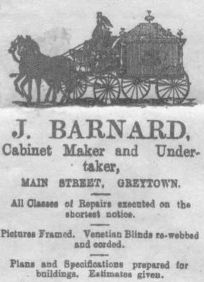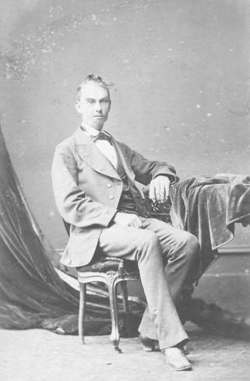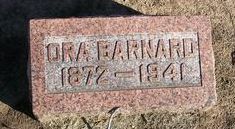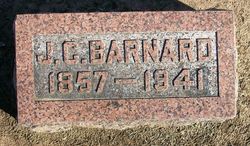Press again for toolbar to return
Joseph Cooper Barnard

Joseph Barnard was born Oct 20 1857 to Thomas Charles and Maria Barnard and received his education in Christchurch and Rangiora. He was no doubt influenced by his older brother Charles to take up the trade of carpentry. In 1872 the family moved to Carterton in the Wairarapa.
1881 - Electorate Wairarapa
Sth; Surname BARNARD; Given Names Joseph; Place Of Residence - Greytown;
Occupation - Carpenter
1882, April 2nd - Recorded as a member of the Masterton Debating Club and produces a chair to the order of the Mason's of Masterton with Masonic emblems. In February 1883, he set up as Cabinetmaker and Undertaker. 1883 - Mr J Barnard of
Greytown, cabinet maker, has made the town gay with posters in many
colours which he inimates that by permission of the stewards he will
exhibit at the race course on the 22 and 23rd the elctric light on the arc
system. The light is not the small thing shown at Carterton bit will be of
50 candlepower. He will also exhibit the electric motor, the organiva,
electric alarm, magnetic bowl and several electric "Fixins". His brother
(Anthong John Barnard) has also made an model sawmill worked by steam
power which will also be exhibited. 1884 Fire at
Greytown. 2 August 1884
About 10 0'clock last night
the Greytown firebell rang out the alarm of fire, and it was found that Mr
J Barnard's cabinetmaker shop was on fire. When first seen the flames were
right through the roof and it was impossible to save the building. The
fire Brigade were very promptly on the ground and were able to save
the next door building but the shop and dwelling-house of Joseph
Barnard, cabinetmaker, were destroyed. The building is the property of the
Wellington Trust and Loan Company. The furniture and effects were
insured in the South British for £200, and the building in the Colonial
for £150.
 Great credit to the firemen
and to the citizens who assisted them
1890 Wairarapa News -
16 December 1890, Page 2
Last night the Palace Hall was re-opened here. For some weeks past Mr. Briggs, the well-known scenic artist, has been engaged in preparing seven large scenes, with wings to match, and also a drop scene. These were exhibited last night. The audience were surprised at the size and beauty of each. Mr. Briggs and Mr. Barnard, proprietor, were called before the curtain, and the Mayor went upon the stage and eulogised the public spirit of Mr. Barnard. Tha agent of the London Bellringers, who was present, informed me that no country town in the colony possessed a hall which had such elaborate and artistic scenery, the drop scene alone being better than those in -some of the largest theatres. The exhibition of the scenes was part of an entertainment which was highly successful. 1891 WAIRARAPA NEWS. 20
March 1891 Greytown,
This day, Mr. Barnard, of
Greytown, whose enterprise in the building and decorating of the Palace
Theatre here is weII known, has taken the Masterton Theatre for three
years. He intends to thoroughly renovate it and provide the best of
scenery.
1891 -Evening Post, 6
March 1891
A very pretty burlesque was
put upon the 'boards of the Palace Theatre not many nights since by Mr.
Barnard, the proprietor. " Aladdin " was the name of the piece, and about
20 ohildren living in the town were the actors. No trouble or expense was
spared in making the performance a surprise to the public, and Mr. Barnard
succeeded. The dresses were magnificent, and the scenery was all new,
painted by Mr. Briggs. All who witnessed the spectacle were delighted.
Evening Post, 1 June
1891,
Friends of Mr. John Tully,
sen., are respectfully requested to attend his Funeral, which will leave
his late residence Greytown, on Tuesday, at 1 p.m. J. BARNARD.
Undertaker
...................................
2007: The refurbished
Greytown Town Hall was opened in 2007 - Gareth
Winter, Wairarapa Archivist writes about the various town halls
in the township.
Greytown's first pakeha
settlers arrived on the site of their newly surveyed township in March
1854. They were people of restricted means from Wellington and the
Hutt, looking to establish themselves on small rural landholdings.
Each of the Small Farms Association settlers was entitled to a 40 acre
farm on the outskirts of the putative village, and a one acre section in
the town. One of the first concerns of the new arrivals was to construct a
public meeting space for the community.
Accordingly, a small
building was erected in early 1857, following a campaign to raise funds
among the few settlers. The leading light in the building was John
Hall, who later recalled that the building, as well as serving as a school
house, was 'open for the worship of all denominations, and for all public
meetings.'
The school room served the community well for ten years but it became clear that the community needed a bigger meeting room. John Hall became involved again, being one of a group who advocated the establishment of a public company to build a more commodious town hall in early 1867. Their advertisements in the
newly-established Wairarapa Mercury stressed that similar companies in
Great Britain and Australia had proven successful, paying a good
dividend. They claimed that their company would probably return 20%
on capital, although they stated that the hall would also prove a great
benefit for 'Public Meetings, Tea Parties, Balls, Concerts, Lectures, and
other Public Entertainments.' Their first meetings proved successful, with
thirty £1 shares being taken up. Samuel Moles was elected chairman
and a provisional board of directors appointed.
 Although the committee was
active in seeking funding, the proposition did not proceed quickly.
In September 1867 the Mercury called for the directors to speak to CR
Carter, the trustee for the Small Farms Association, in the expectation
that he would provide them with one of the reserve sections for their
building. A new committee was elected, with Thomas Kempton and
George Beetham taking prominent roles. Although the committee was
active in seeking funding, the proposition did not proceed quickly.
In September 1867 the Mercury called for the directors to speak to CR
Carter, the trustee for the Small Farms Association, in the expectation
that he would provide them with one of the reserve sections for their
building. A new committee was elected, with Thomas Kempton and
George Beetham taking prominent roles.There was discussion about the site of the proposed hall, one group insisting that the hall needed to be in a central part of the township, while others claimed that the cheapest procurable section should be used. In the end it was resolved to ask Carter for a piece of land, and eventually they purchased a section from the Small Farm Association, section 61, just south of St Luke's Church. In March 1868 the Mercury reported that plans had been prepared by B Smith, a man was employed clearing the site, and tenders were about to be called for building the hall, but things still moved slowly. In July a completion date of December was agreed on with the contractor, but in January 1869 the hall was still not finished, two years after the first proposals. The hall was finally finished in early February, and a opening concert planned to coincide the Wairarapa Races and the visit of Governor Bowen on 17 February. The Mercury reported that the opening of the hall was very successful; the singing was good and the attendance large. The following night a ball was held in the hall. The Mercury published a poem to mark the visit of the Governor, which included the following lines: The first day at the new
Town Hall, A Concert grand was given
The Muses and the Graces came, some walked and some were driven, They sang and played delightfully, and dwelt on stops and pauses, The married and the single dames contended for applauses; And those were always loud and long, the ladies all appearing To love the kind approving smile, and all the generous cheering. In truth the Concert was so good, so musical the jingle That song and glee and melody, came forth to charm and mingle. The town hall company did
not meet with success however, the promoters claims of a 20% return soon
proving hollow. In late June 1872 a public meeting called upon the
Greytown Trust Lands Trust, successors to the old Small Farms Association
and formed the previous year, to buy the hall. The trust acceded to
the request and ownership passed into their hands.
For the next sixteen years the Town Hall was the largest meeting place in the town. It was used by visiting theatre troupes, local amateur theatrical societies, churches, lodges, and the Greytown School. In the mid-1870s it was nearly converted to an immigration barracks, but a building of Thomas Kempton's was eventually chosen. Among the more interesting visitors was Professor Bruce, who ran his hands over the heads of various local worthies as he made his phrenological deductions at to their character, as well as displaying his hypnotism skills. The Town halls pre-eminence as a meeting place was under threat. The Foresters Lodge, the Masonic Lodge and the Fire Brigade all built their own halls, but it was the arrival of the Palace Hall Skating Rink that was to be the biggest threat. The privately-owned hall was
the brainchild of Joseph Barnard, a local cabinetmaker, undertaker and
entrepreneur. Barnard was one of the children of the Carterton
watchmaker Thomas Barnard, and provided joinery for many of the public
buildings in Greytown, including the Greytown Borough Council chambers.
The Palace Hall was the talk of the town when it opened with a plain and fancy dress ball in November 1888. It was sited on the first floor of a new building, the ground floor being occupied by two shops, a two metres wide entry to the hall being left in the centre. Above the entry was a balcony which opened into the gallery of the hall. The hall was 38 metres long and 12 metres wide with a special floor laid in such a manner as to give no skating vibration to the walls or floor. Galleries were built along each side and in the front, allowing for an extra 300 people to be seated. The new hall seemed assured
of success even more so when its competitor, the Trust Lands Trust's old
Town Hall burnt down in November 1889. The Oddfellows Lodge held their
annual ball in the hall on the 12th. Shortly after the ball goers
had left the hall at about four in the morning of the 13th, smoke was
noticed coming from the hall and the alarm was raised. It was to no
avail. The old building was quickly ablaze, the fire also spreading
to the fire brigade shed and other outbuildings. The brass and string
bands equipment was stored in the hall, along with much Oddfellows
regalia. All was lost. Braggins shop, another Trust property
next door, was at threat from the fire but the brigade managed to hold the
flames to the old hall, although Mrs Braggins, an invalid, was taken to
safety with neighbours, her house was scorched and damaged.
The Trust Lands Trust had not insured the building for its full value and was reported to be some three or four hundred pounds out of pocket. They quickly decided that there seemed to be no need to have another hall in the town and they announced they would not be rebuilding. It seemed the success of Joseph Barnard's Palace Hall was assured. Barnard branched into other
theatrical affairs, taking over the lease of the Theatre Royal in
Masterton, another privately-owned hall that doubled as the town
hall. He staged theatrical entertainments in both towns, and shortly
after the first hall burnt down, installed an electric lighting plant in
the Palace Hall. The system was powered by a six horse power
steam engine which drove a generator that lit 40 incandescent lamps.
The stage lighting was controlled separately for dramatic
effect.
A report in the New Zealand
Times in 1891 described the Palace Hall in glowing terms, referring to the
stage's backdrop of the Bay of Naples, and to the electric lighting,
saying the electric system was only used when special arrangements had
been made, kerosene lamps being the more usual form of lighting.
Joseph Barnard acted in his own productions, his acting being described as splendid in a review of an 1892 productions of Our Boys along with his brother Anthony. At the end of the show the local minister congratulated Barnard for his centerprise in adding such a magnificent building to the township. But Barnard's time in
Greytown was quickly drawing to a close. Financial pressures on the
young entrepreneur were mounting and in 1893 he fled the town, owing
hundreds of pounds. A warrant was issued for his arrest, but a series of
delays meant he managed to stay one step ahead of the police, and he is
thought to have boarded a steamer in Auckland and headed for
America.
A correspondent wrote to the
Wairarapa Daily Times with a fetching story of having met a tall,
statuesque woman on the corner of Queen and Shortland streets in
Auckland. It seems Joseph Barnard slipped out of New Zealand,
dressed as a woman. He was the sensation of the moment, but then
people forgot about him. A report some years after claimed that he
was either the star of a huge American travelling theatre troupe, or had a
show of his own, or had even passed his exams and was practising as a
doctor.
In fact, he went to Oklahoma
where he married, he worked as building contractor, employed many men and according to the
1930 census, a statis symbol of the time, owned a radio set. He died in 1941.
The Palace
Theatre was taken over by Robert and James Judd, two farmers, but they
soon sold it on to tobacconist and hairdresser John Robertson.
Australian-born Robertson bought the site in 1902. By 1906 he was
renting the other shop to the Carterton-based photographer John Yerex, but
in March of that year this building too was lost to fire. .....................................
1893 Evening Post, 14
August 1893
Greytown North; There is great excitement about J. Barnard's alleged absconding, and many rumours are current concerning his supposed arrest . It is stated that he was arrested at Auckland on Saturday (to which place he travelled overland), and he was identified by Mr. M. Caselberg, of Masterton, who was visiting Auckland. He is supposed to have £lOOO on contracts in hand. A warrant was issued last Friday. There is no official notification, but one is hourly expected. [The police have received information that the warrant for Barnard's arrest reached Auckland after the outward San Francisco steamer had sailed, and that it is supposed he was a passenger by her.] 1893 Evening Post, 15 August 1893, Page 2
WAIRARAPA NEWS.
Greytown North; Joseph Barnard, the contractor as to whom a warrant has been issued oharging him with absconding with a large sum of money, sailed by the San Francisco boat on Saturday afternoon from Auckland, as the warrant was not received in time to intercept him. A meeting of creditors will probably be held to-day. 1893 - WAIRARAPA NEWS.
Evening Post, 11 September 1893
Joseph Barnard, contractor,
who recently levanted from Greytown, was to-day declared
bankrupt  1893 - WAIRARAPA
NEWS.Evening Post, 19 September 1893
Greytown North. At a meeting
of creditors in the estate of Joseph Barnard, the absconder, held to-day,
it was decided to invite tenders for the disposal of the Palace Hall, and
realise on the piano, etc. The liabilities are £785, including mortgages.
1893 Evening Post, 5
October 1893, WAIRARAPA NEWS.
Greytown North. A meeting of the creditors of Joseph Barnard was held to-day. No tenders .were received for the hall. It was decided not to apply to the Farmers' Co-operative Society and Stewart & Co. for the refund of the amounts obtained before the debtor absconded. 1893 - Evening Post,
27 September 1893,
IN BANKRUPTCY. Estate of
JOSEPH BARNARD, of Greytown N., Contractor. TENDERS aro invited by the
under- signed up to 12 o'olock noon on Wednesday, 4th October, 1893, for
the purchase of the equity of redemption of part section fourty-two,
Greytown, containing thirty- four perches, with building thereon,
including the PALACE HALL, two Shops and Photographic Studio, one piano,
and all scenery and skates therein, the property of the above-named
Bankrupt. The highest or any tender not necessarily accepted. Terms and
conditions of tenders, with particulars of property, may be seen at the
offices of the Permanent Investment and Loan Association, Greytown, and
the undersigned. W. B. CHENNELLS, Deputy Official Assignee. Masterton,
19th September, 1893.
Bush Advocate, 21
October 1893
Barnard, the defaulting
contractor from the Wairarapa, has written to a Masterton resident, from
Chicago, stating that it takes six weeks to go through the World's Fair,
upon which the Star remarks : ' It does not take quite so long, however,
to go through the unsophisticated of Greytown."
Marlborough Express 22
December 1893 .
Advice has just reached Masterton that "Joe" Barnard, the levanting carpenter, late of Greytown, is at present touring the United States with a Dramatic Company. WAIRARAPA NEWS. Evening
Post, 2 December 1893
Masterton,. The wages claims
in the bankrupt estate of Joseph Barnard who recently absconded from
Greytown will be paid in full, and a dividend of 2s 6d in the £ is to be
declared through the realisation of certain property.
24 August 1904, Patent
768,166 - United States Patent Office Oklahoma: P1 P2 To all whom it may concern, be it known that I,
Joseph Barnard, a subject of the King of Great Britain, residing in
Oklahoma, have invented a new and useful Corn husking
machine............ Joseph's invention was able to be attached to the existing corn harvester. The object was to remedy the existing problem that when the heavy outer husks of of corn were removed, the thin inner husks remained. Now the husks were able to be entirely removed without damage occuring by shelling the ears of the corn.
1930 Census - US
Federal 1930
State:
Oklahoma County: OKLAHOMA CITY, WARD 2 BOUNDED BY (N) 5TH; (E) LINDSAY
AVE, 4TH, BYERS AVE; (S) 2D; (W) CENTRAL AVE
Household: Hammond, William (b: 1903*) Hammond, Jennie (b: 1905*) Hammond, Dorothy Jene (b: 1927*) Joseph Barnard,age 72 born NZ, building contractor Married 1893 at age 46; his wife Ora, age 57; born c1873 Illinois; Married 1893 age 31; Value of house $6000; at 526 E 5th; Newspaper reports - Deaths: Joseph Barnard died Feb. 26, 1941 and his wife to a gas leak He had become an American citizen. She died four days later (30 Feb 1941, age 75 yrs. Joint Cemetery arrangements at Garrison Funeral Home. Buried Fairlawn cemetery. Ora had 4 sisters in Belleville ,
Illinois one sister, Mrs Olive Whiteside aged 50 visiting was in an
upstairs room and not affected by the fumes. (Please
contact if you have information about Joseph's life in
America)
Oklahoma City Oklahoma County Oklahoma, NEWSPAPER REPORT A retired contractor, Joseph C Barnard, a
retired contractor, who prepared for death by making his own coffin,
was found dead in his home. When police broke into the home, fireman said
he had been overcome by corbon monoxide gas exscaping from a gas
stove. The coffin was located by police in a garage at the rear of the home inside a steel vault, where it had been stored since 1933. With it was a list of men requested by Barnard as bearers at his funeral and detailed instruction on removal of the coffin from its vault. Barnard's wife Mrs Ora P Barnard (75) was overcome by the gas but was revived by a pulmotor squad and was removed to OKC General Hospital. Her sister Mrs Olive Whiteside who came here three weeks ago from Belleville, Ill., was asleep in an upstairs room and was not affected by the fumes.. Dora Seibles called police after she went to the home with rent money and was unable to get an answer to knocking. She saw Barnard's body on the floor and his wife nearby.Barnard was apparently writing a note to friends when overcome. asphyxiation caused by carbon monoxide gas. A friend reported he was told about the casket made in 1933 and that the vault had been bought for it's storage. |





